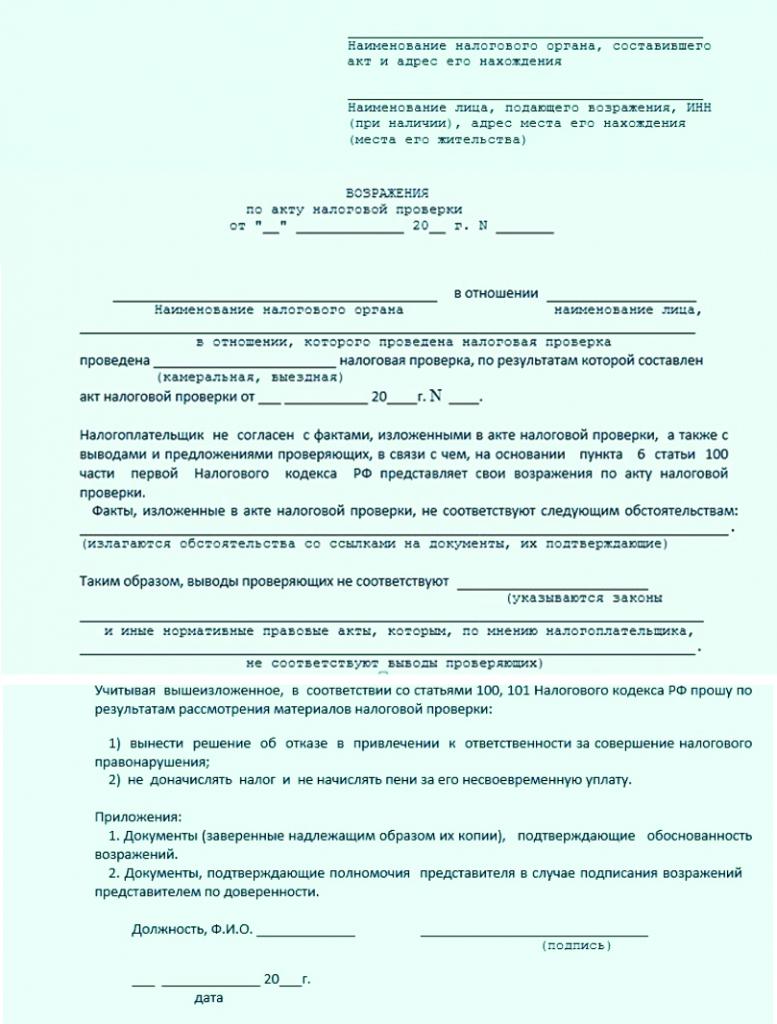Tax audits are an unpleasant event for every company. They are held for all organizations or entrepreneurs working for more than three years. The basis may be a special inspection plan or regular complaints about the company. Often the results of such inspections are unsatisfactory for entrepreneurs, they are held accountable for numerous violations. If the inspectors during the study violate different rules and requirements, then a businessman may draw up an objection to the tax audit act. If it is satisfied, then the results of the verification will not be accepted.
Objectives of the drafting
An objection must be made on behalf of the company, which was evaluated by tax inspectors. The main objective of an objection to the act of an on-site tax audit is the opportunity to appeal the results of this study, which will avoid the charging of significant fines.
Taxes during the study of enterprise documentation may make various errors:
- procedural, in that the inspector uses the wrong procedure for conducting the process or violates the requirements of the law;
- violations of substantive law, as often inspectors themselves may not have sufficient competence to correctly interpret various complex accounting documents.
An objection is filed directly with the Federal Tax Service, and the specialists of this organization must necessarily respond to this document. Based on it, an audit is conducted to identify the presence of violations by inspectors.

What actions should not be appealed?
Often, business owners even try to invent various violations that are allegedly committed by an inspector, but in reality they are insignificant or simply absent. It is not recommended to file an objection to the tax audit act on the basis of the reasons:
- changed by the auditor the dates during which the audit was carried out;
- various inaccuracies are identified in the preparation of the protocol;
- There are minor procedural deviations from the requirements.
Such reasons are insignificant, therefore, they are not usually considered by the Federal Tax Service. But if there are no other violations, then it is allowed to apply to the court with such problems. With the help of a court, a taxpayer can invalidate an act, therefore, all information contained in it cannot be used to hold the company accountable.
If the objection contains references to a violation of the verification procedure, this may become the basis for the inspection to appoint control measures, which often leads to the identification of more serious violations.

What grounds should be indicated in the document?
Before directly drawing up an objection, it is recommended to think through all the arguments in advance and prepare evidence confirming the actual violations by the inspecting inspectors.
It is optimal when drawing up a written objection to the tax audit report to indicate the grounds for contesting the results:
- if at the time of the study the employees of the company did not have any documents for various reasons, but they were quickly restored or corrected inaccuracies, then this fact is necessarily recorded in the document, which will reduce the size of the forfeit;
- any argument should be explained in detail, for which reference is made to circumstances on the basis of which certain shortcomings or problems arose;
- when drawing up an objection, it is relevant to use links to various regulatory acts.
If the above arguments and arguments are really correctly substantiated and proved by official documents, then the tax authorities will not be able to challenge them. Additionally, an objection to an act of a tax audit can be used in court if no action is taken by the inspection. Often the court takes the side of companies.

Where does the document go?
An objection to the tax audit act must be submitted directly to the department of the Federal Tax Service, whose employees were involved in the study. The procedure can be performed in various ways:
- personal transfer of the document to the employee of the Federal Tax Service by the entrepreneur or his representative;
- sending documentation by mail, for which a registered letter is used, and a delivery receipt is paid;
- using electronic services, but the company must have a digital signature under these conditions.
In the first case, it is recommended to make two copies of the document so that one of them has a mark of acceptance.
When is the document transmitted?
For a desk or field audit, the same term of opposition to the act of tax audit is used. The process should be carried out within one month after the head of the enterprise receives an act of research.
If this period is violated, then it will not work to challenge the act. To do this, you will have to go to court, but even in this case, it is likely that the lawsuit will not be accepted.

Document Content
There is no unique and clearly established model of objection to the tax audit act, therefore, employees of different organizations can generate this documentation in free form. For this, it is taken into account what kind of inspection was carried out, what violations were discovered, and also in which field of activity the company operates.
When drafting a document, it is advisable to follow some recommendations. Therefore, information must be included in the objection to the tax audit report:
- name, address and branch number of the Federal Tax Service where the documentation is sent;
- information about the direct sender, provided by the name and address of the company in respect of which the check was carried out;
- the number of the objection is registered;
- the date of its formation is indicated;
- the main part denotes the act in respect of which an objection is formed;
- describes in detail what the essence of the complaint is;
- all available arguments, evidence and arguments are introduced;
- links to various legislative acts confirming the correctness of the applicant are left.
Other papers are attached to the correctly drawn up document, which are evidence of violations by inspecting inspectors. A sample objection to the act of cameral inspection is located below.

The nuances of the formation of the document
When compiling such a document, it is not necessary to focus on different recommendations or requirements of the Federal Tax Service, therefore it can be formed in writing or in print. The employees of the enterprise themselves choose in what sequence different information will be entered into the documentation. In this case, it is desirable to enter only reliable information. There should not be too much text.
A sample objection to a tax audit report shows that a summary of the facts is the right choice. When it is formed, recommendations are taken into account:
- a standard A4 sheet is used, and companies are also allowed to use their own letterhead;
- documentation must be signed by the head of the enterprise or other responsible person endowed with the appropriate authority;
- if the authorized person of the director of the company is engaged in the sighting, then the number of the power of attorney must be additionally written in the objection;
- it is not required to certify the document with the organization’s seal, since since 2016 companies may not use different stamp products during operation, unless otherwise specified in the constituent documentation of the enterprise.
The document should be drawn up in two copies at once. One of them is sent directly to the inspection, and on the second, employees of the institution must put a mark on acceptance.

Document Transfer Specifics
The process can be performed in person or by mail. If the first option is chosen, a cover letter is attached to the objection. It is formed in the form of a statement in duplicate.
The letter indicates that an objection is sent to the Federal Tax Service on a specific inspection act. This document should also be marked with the acceptance by the employee of the inspection.
Document Review Period
The most frequently formed objections to the tax audit act for various deficiencies in taxes. Personal income tax is considered the most significant fee for each company, and often the accountants of enterprises make various errors in its accrual or return.
The claim is reviewed by the head of a specific branch of the Federal Tax Service. The decision is made within 10 days from the day when the deadline for filing an objection with the inspection ends.
It is allowed for various reasons to extend this period, but (according to Article 101 of the Tax Code) this process is implemented for a maximum of one month. FTS employees are required to notify company management of where and when materials related to a previous audit will be reviewed.

What decision can be made?
Most often, companies draw up a document based on identified errors in the rules for calculating and paying personal income tax. The sample objection to the tax audit report should contain information about exactly what violations were on the part of inspectors. Additionally, you can specify that various inaccuracies in tax calculation are associated with objective and compelling reasons.
The decision is made quickly enough, and it can be presented in two versions:
- the taxpayer is brought to justice, as violations by inspectors are minor;
- The head of the Federal Tax Service refuses to hold the company accountable on the basis of Art. 101 of the Tax Code, since the inspectors really made many mistakes, therefore, the act drawn up by them cannot be recognized as relevant and valid.
If, even if there are good reasons and reasons, the management of the Federal Tax Service still makes a decision to hold the company accountable, then the company can file a lawsuit. A copy of the objection is attached to it, as well as other documents, on the basis of which the correctness of the company is confirmed. To win the trial, it is recommended to use the help of professional lawyers.

Conclusion
Often, the leaders of different companies do not agree with the results of tax audits. If they have good reasons for this, then they may raise an objection to the act of a tax audit of VAT or another tax. This requires official and documented evidence that the inspectors actually violated the law or the rules for drawing up the act.
It is important to understand how this document is compiled correctly, what information is included in it, and also by what methods it is sent to the head of the department of the Federal Tax Service, whose employees were involved in the audit.


